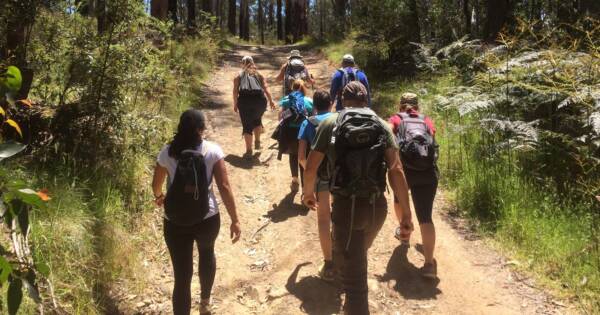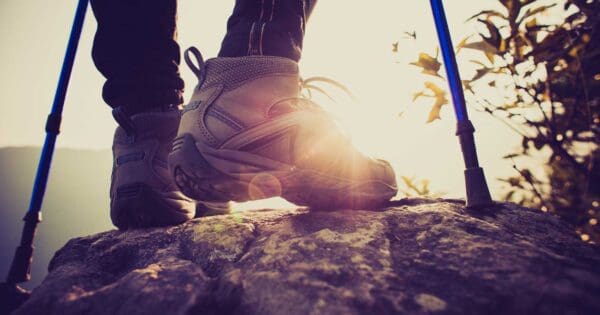When it comes to hiking on challenging terrain, having the right gear can make all the difference. While Australia may not be known for snow-covered trails in all states year-round, microspikes are still an essential tool to consider for your kit. Whether you’re navigating muddy tracks, slick rocks, or river crossings, these lightweight traction devices provide the grip needed to hike safely and confidently.
What are Microspikes?
Microspikes are small, flexible chains with stainless steel spikes designed to provide additional traction on slippery surfaces. The spikes are attached to a durable rubber harness that stretches over your hiking boots or shoes, giving you better stability on ice, packed snow, mud, or wet rocks. They’re lightweight, easy to carry, and perfect for moderate conditions, unlike crampons, which are designed for more extreme terrain.

Where Would You Use Microspikes?
Although not all regions of Australia experience icy trails, microspikes are extremely useful in a variety of conditions:
- Mud and Wet Terrain: After rain, trails can become slippery with mud. Microspikes help dig into the soft ground, giving you better footing.
- River Crossings: Wet, slippery rocks can make river crossings tricky, but microspikes improve traction on these slick surfaces.
- Steep, Rocky Slopes: For scrambles over loose or rocky terrain, microspikes provide grip and stability.
- Leaf-Covered Tracks: Wet leaves on forest trails can be hazardous, and microspikes help you keep your balance.
- International Adventures: For those planning to hike abroad, especially in regions with snow and ice, microspikes are essential for walking on packed snow or frozen trails.

Benefits
Microspikes offer numerous advantages for hikers, making them an indispensable tool in a variety of conditions:
- Versatility: Suitable for various terrains such as mud, ice, wet rocks, and even river crossings, making them a great all-around traction device.
- Lightweight and Portable: Microspikes are significantly lighter and more compact than crampons, easily fitting into your backpack or jacket pocket without adding unnecessary bulk.
- Easy to Use: They are quick to put on and take off, requiring no special skills or tools. Simply stretch the rubber harness over your boots or shoes, and you’re ready to go.
- Affordability: Microspikes are generally more affordable than crampons, offering a cost-effective solution for hikers.
- Safety: By providing reliable traction on slippery surfaces, microspikes reduce the risk of slips and falls, increasing your confidence and safety on the trail.
- Efficiency: With the traction that microspikes offer, you can focus on your hike without the constant worry of slipping, reducing physical and mental fatigue.
Disadvantages
While microspikes are incredibly useful, they have limitations:
- Limited for Deep Snow or Steep Ice: Microspikes are not designed for steep alpine conditions or deep snow, where crampons or showshoes are more appropriate.
- Not Ideal for Hard, Rocky Terrain: The spikes may wear down quickly on rocky surfaces and are less effective on hard rock.
- Potential for Overconfidence: Although microspikes improve traction, hikers should remain cautious in extreme conditions.
- Weight: While wearing spikes adds some extra weight to your feet, using them in the right conditions can help conserve energy rather than drain it. It’s best to hold off on putting them on until you encounter terrain that truly needs them.

How do they differ from crampons?
While both microspikes and crampons offer extra traction, they serve different purposes. Crampons are designed for steep, icy terrain and mountaineering, with larger, sharper spikes for penetrating deep ice. Microspikes, on the other hand, are more versatile and lighter, designed for less extreme conditions like icy trails, packed snow, and muddy or rocky terrain. Microspikes are perfect for most Australian hikes where crampons could be overkill, depending on when and where you go in the Australian Alps.

Sizing and fit
Microspikes typically come in a range of sizes, from Small to Extra-Large, to fit different boot or shoe sizes. It’s important to match the Microspike size to your footwear to ensure a snug fit. If they’re too loose, they may come off during your hike; if too tight, they could cause discomfort. Fitting microspikes is simple. Stretch the rubber harness over your shoe or boot, with the spikes resting on the sole. Ensure the spikes are evenly spaced and securely fastened.
Caring for your microspikes
To extend the life of your microspikes, proper care is essential:
- Snow/Ice Buildup: Snow and ice can sometimes accumulate around the spikes, forming a layer that reduces their effectiveness. A quick solution is to give the bottom of your feet a firm tap with your trekking poles. If that doesn’t do the trick, simply remove the spikes and shake off the built-up ice and snow.
- Clean After Each Use: Rinse them off after using them in muddy or wet conditions to remove dirt and debris.
- Dry Thoroughly: Allow them to dry completely before storing to prevent rust and keep the rubber harness in good condition.
- Store Correctly: Store your microspikes in a cool, dry place, away from direct sunlight, which could cause the rubber to deteriorate. A storage bag can protect the spikes and keep them organised.

Addressing Common Concerns
- Effectiveness in Mixed Conditions: Microspikes perform well on a variety of surfaces like ice, mud, and wet rocks, though they may not provide optimal grip on hard, rocky ground.
- Impact on the Environment: Concerns about damaging trails with microspikes are minimal. The small spikes are unlikely to harm trails and may even help prevent erosion by reducing slips in muddy conditions.
Final Thoughts
While microspikes may not always come to mind when hiking in Australia, they are a versatile and essential tool for hikers navigating a variety of challenging conditions. Whether you’re dealing with muddy trails, slippery rocks, or icy patches, they provide the grip and stability you need for a safer hike. Lightweight, easy to use, and affordable, microspikes are an excellent investment for any hiker’s kit. Proper care will ensure they last through many adventures, and by addressing common concerns, you can use them responsibly and effectively. Whether hiking locally or abroad, microspikes can help keep you steady on your feet.





